These photographs are from the inaugural John Jay High School Model United Nations Conference (JJMUNC), hosted on November 15, 2014 at John Jay High School in Cross River, New York.
This is a large group of well-dressed teenagers. I wonder what they’re doing?

Conference: A conference in Model United Nations (MUN) is normally hosted by a MUN organization or club at the middle school, high school, or collegiate level. They are attended by various Model UN clubs, and students debate against other pupils. Students, also known as delegates, represent countries in different committees that attempt at resolving the issues before the committee. Often conferences award delegates on their level of debate and negotiation skills. Conferences are a way for delegates to simulate the proceedings of the United Nations in a larger scale than at their club meetings or training sessions. A lot of preparation takes place before a conference through research and strategy development. Conferences are truly the highlight to any Model UN season because you get to meet students from different programs and share your ideas with others.
Now they are in a classroom. I wonder what they are doing. They look very professional.
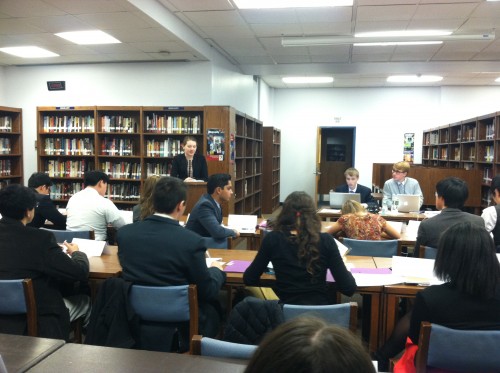
Formal Debate: Formal debate consists of a speaker’s list. Delegates can be added or re-added at any time to the speaker’s list, usually by passing a note to the dais. Once a speaker is recognized, they may speak in front of the committee for an allocated time, generally between 45 and 90 seconds. After the delegate speaks, they may yield to points, another delegate, or the chair. Yielding to points allows other delegates to ask questions, or points of information, of the delegate. Yielding to another delegate allots the rest of your time for them to speak- this should generally be used to yield time to someone sharing the same views as the original delegate. Yielding to the chair lets the dais absorb the time the delegate has remaining.
Who are these people sitting at a table in front of the room? I guess they are in charge?
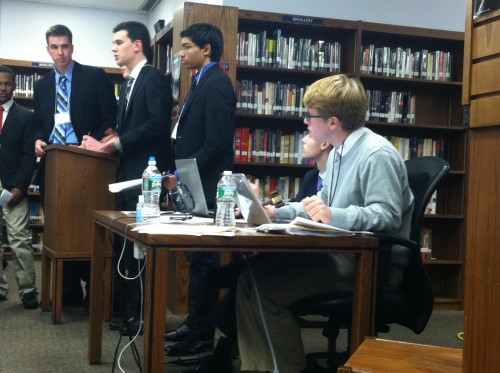
Dais: The dais is the group of people who moderate debate. Most daises consist of a chair, a director, and a rapporteur. The chair presides over committee sessions utilizing parliamentary procedure and keeps the flow of debate going. The director assists delegates with working papers and also presides over the procedure for draft resolutions, amendments, and voting. The rapporteur keeps the time and quorum for the committee sessions at the conference.
Oh, it must be break time?
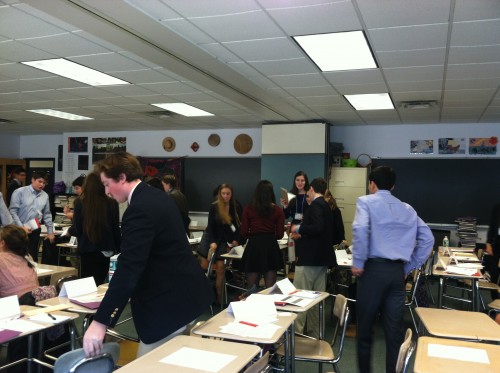
Informal Debate: Informal debate is separated into moderated and unmoderated caucuses. Moderated caucuses are still overseen by the dais, while the unmoderated caucuses are not.
Moderated Caucus: Moderated caucuses are motioned for by a delegate for a certain duration of time and a certain speaking time. Moderated caucuses also need to have a specific topic for the committee to discuss. This topic can be somewhat different than the agenda topic and is used to discuss a subtopic of the main committee topic. Moderated caucuses are a great way to hear more delegates speak and to address a variety of topics within the given issue.
Unmoderated Caucus: An unmoderated caucus is a type of informal debate where delegates can move around the committee room to discuss the topic with other delegates and to create resolutions regarding the issue. Unmoderated caucuses can be motioned for when the floor is open and are recommended once a majority or all of the committee speaks in formal debate. Unmoderated caucuses are a great way to begin forming your bloc or blocs for working papers.
Nope, they are still working at it. Why are they are huddled around that computer?
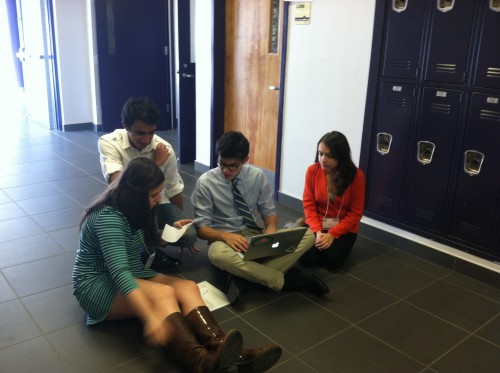
Working paper: A working paper is a document delegates create to resolve the issue their committee is discussing. The working paper has sponsors, who created the main components of the paper and support its content, and signatories, who sign the paper to see it debated during committee session. Working papers become draft resolutions when they are submitted to the dais, and they finally become resolutions once they pass in the committee.
Wow- they are working hard on these papers. It is a break, and they are still writing!
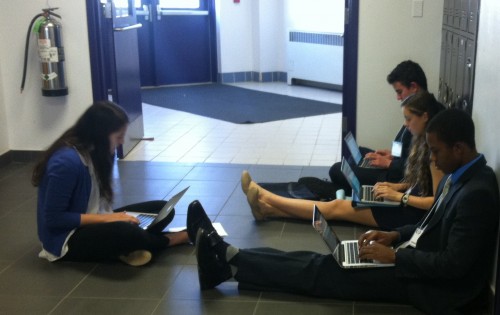
The delegates seem to be reading those papers in front of the committee.
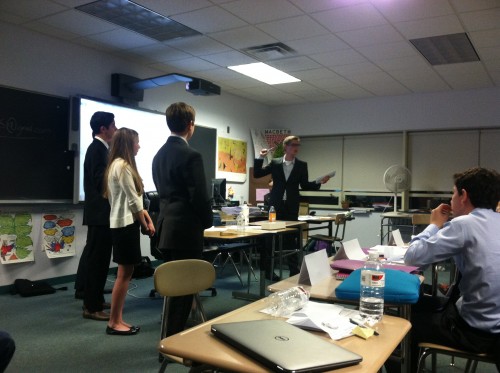
Authors’ panel: An author’s panel occurs when draft resolutions have been printed and are ready to be debated. The sponsors of the draft resolution read their work and then have a question and answer session before the committee. This panel allows them to clarify any issues delegates have with the draft resolution. The panel and committee also edit the draft resolution for spelling and grammatical errors in this process. The authors can express their support for their draft resolution and justification here as well as discuss any amendments they would be willing to see made in committee.
Now the delegates are raising those name cards for some reason?
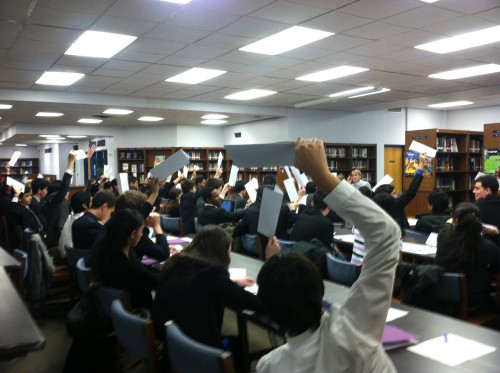
Placard: Placards are the pieces of cardstock or plaques that have the delegation’s country name on them. They are used to indicate if your country is voting on a procedural matter or if they wish to say something in committee.
They locked me out of the committee room! What gives?

Amendments: The amendment process takes place before voting procedure. Amendments are often used to get a larger consensus of the committee to vote in favor of your draft resolution. If there are any amendments on the floor, the dais will make the committee aware of them, as well as their associated resolutions. If all the sponsors are in favor of including an amendment in their draft resolution, it is called a friendly amendment. Friendly amendments get added automatically to the draft resolution. If the sponsors are not unanimously in support of added the amendment to their draft resolution, it is called an unfriendly amendment. These type of amendments must be voted on by the whole committee. The authors of the amendment normally need 20% of the body to be signatories in order to introduce it. If the unfriendly amendment is introduced, the committee votes to have it added by a simple majority vote.
Voting procedure: Voting procedure is the time during committee when delegates must remain quiet and stay in their seats for the duration of the vote. It is important that all the delegates are present in the room at the time voting procedure occurs, or else they will be barred from the committee room and will not be able to participate in the vote. Amendments for each resolution are voted on prior to voting on each resolution. Delegates may vote for or against a draft resolution, or they can abstain. A vote for the resolution means that the delegate agrees with its content; a vote against means they do not. An abstention means they do not want their vote counted in the overall vote. Once the dais calculates the results and informs the committee if the draft resolution passed or not, then voting procedures are over, and the committee may begin their next topic on the agenda.
So what happens now?
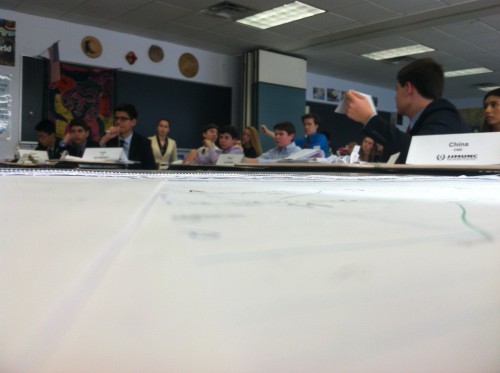
Back to debate!

